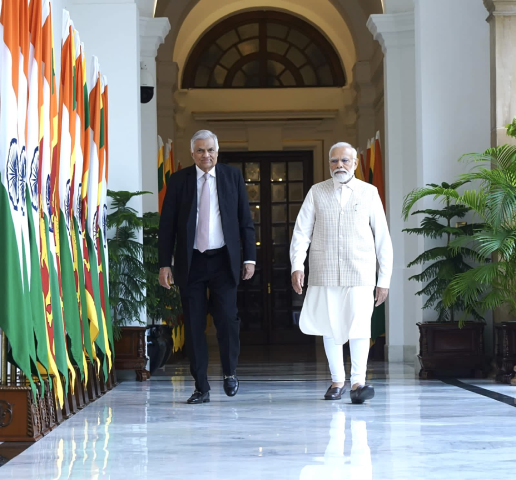The visit of the Sri Lankan President Ranil Wickremesinghe to New Delhi has a central message, of establishing a primary relationship with India.
Sri Lanka’s pivot to India is being guided by a slew of connectivity initiatives that will bring together the people, businesses, and cultures of the two countries that share a unique civilizational history.
Wickremesinghe appeared to hinting at India-Sri Lanka special civilizational relationship when he said in his opening remarks during talks with Prime Minister Narendra Modi that the “foundations of our joint vision of greater future connectivity have already been laid through millennia-old civilisational, cultural, human and commercial interactions between our two countries.”
A slew on novel connective initiatives would be laying the foundations of a special relationship that has a long shelf-life.
With India playing a primary role in developing north and northeast Sri Lanka—areas with a large Indian origin ethnic Tamil population—the two countries have zeroed on Trincomalee, the world’s fifth largest natural harbour, and Jaffna as the hubs of their partnership.
“The development of Trincomalee as an energy hub with the support of India is a crucial step towards Sri Lanka’s goal to elevate Trincomalee as a hub for industry and other economic activities,” said Wickremesinghe.
Indian Oil has already built an oil tank farm that will store large volumes of petroleum to avert an energy crisis in the island nation.
Besides, a new structural node is being added following a decision to link Sri Lanka and India via a new energy pipeline.
“Prime Minister Modi and I believe that the construction of a multi-product petroleum pipeline from the Southern part of India to Sri Lanka will ensure an affordable and reliable supply of energy resources to Sri Lanka,” the Sri Lankan President added.
A new trade node is also being added by linking Tuticorin in Tamil Nadu with Colombo.
As reported by Indian Narrative, Keith Bernard, the head of the Sri Lanka Ports Authority (SLPA) visited Tuticorin earlier this week along with a high-profile delegation which included representatives from SLPA, South Asia Gateway Terminals, and the Colombo International Container Terminals on a three-day visit.
“Both the Colombo and Tuticorin ports, situated in the Indian Ocean region, hold strategic importance as key maritime trade hubs. Establishing a commercial shipping trade relationship between these ports presents numerous opportunities for collaboration and growth,” the SLPA chairman said at a trade interactive session on establishing a robust networking system between the Colombo port and Tuticorin.
India’s tycoon Gautam Adani, who met the Sri Lankan President this morning also tweeted about the range of collaboration on the infra sector in Colombo.
“Great Honour to have met H.E. President Ranil Wickremesinghe to discuss a fascinating set of projects in Sri Lanka including continued development of Colombo Port West Container Terminal, 500 MW wind project, and extending our renewal energy expertise to produce green Hydrogen,” tweeted Adani.
Besides, the two leaders have flagged off several people-to-people connectivity initiatives focusing on Tamil Nadu and northern Sri Lanka.
These include starting of a passenger ferry services between Nagapattinam in Tamil Nadu and Kankesanturai in Sri Lanka.
The two sides decided to work towards early resumption of ferry services between Rameshwaram and Talaimannar, and other mutually agreed places. A joint declaration of intent was also signed on UPI payments—a move catering for promoting tourism and businesses.















